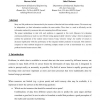Free Online Productivity Tools
i2Speak
i2Symbol
i2OCR
iTex2Img
iWeb2Print
iWeb2Shot
i2Type
iPdf2Split
iPdf2Merge
i2Bopomofo
i2Arabic
i2Style
i2Image
i2PDF
iLatex2Rtf
Sci2ools
IJPRAI
2006
2006
Selective Voting - Getting More for Less in Sensor Fusion
Many real life problems are characterized by the structure of data derived from multiple sensors. The sensors may be independent, yet their information considers the same entities. Thus, there is a need to efficiently use the information rendered by numerous data sets emanating from different sensors. The proper methodology to deal with such problems is suggested in this work. Measures for evaluating continuous predictions are used in a new efficient voting approach called "selective voting", which is designed to combine the prediction of the models (sensor fusion). Using "selective voting", the number of sensors is decreased significantly while the performance of the integrated model's prediction is increased. This method is compared to other methods designed for combining multiple models as well as demonstrated on a real life problem from the human resource field.
Related Content
| Added | 13 Dec 2010 |
| Updated | 13 Dec 2010 |
| Type | Journal |
| Year | 2006 |
| Where | IJPRAI |
| Authors | Lior Rokach, Oded Maimon, Reuven Arbel |
Comments (0)

